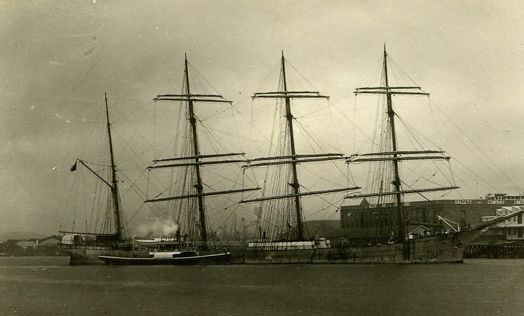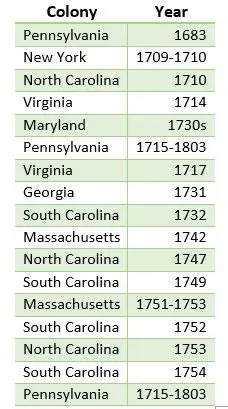German Immigration
Even before either place was a country, Germans crossed the ocean to begin new lives in America. Later, millions of Germans made this journey beginning in the late seventeenth century and into the twentieth century. These German Americans brought their traditions, forming their German communities on this side of the Atlantic. If you are of German descent, your ancestors were among these immigrants. This blog focuses on the experience of Germans immigrating to America.
History
In colonial America, any non-English speaking group was considered a minority. This included the German Americans, who continued speaking German until the early twentieth century. They were the largest minority group in colonial times.
The Pennsylvania government was worried about the political imbalance caused by the influx of German immigrants. Their solution was to have Germans naturalize. German colonial naturalizations involved renouncing their allegiance to their former German states. This, of course, left a paper trail valuable to genealogists today.
Many emigrants leaving Germany traveled and settled together. Because of this practice, looking for neighbors can be helpful when you can’t find your ancestor. The FAN (Friends Associates Neighbors) club also includes people and families adjacent to each other on passenger lists and naturalization records. Many immigrants kept the same occupation on both sides of the ocean, which can help identify your ancestors. Not all Germans kept the same occupation upon immigration—those who did not find a job after arriving would have had to change careers.
Emigration and immigration laws
Germany was not a country until 1871, almost a century after the United States became a country. Until then, German emigrants were leaving principalities, kingdoms, and dutchies. When stating their place of origin, German immigrants would either say Germany or name the German state.
Each German state had its laws regarding emigration, which the emigrant may or may not have complied with. Generally, emigrants had to fulfill required military service, pay any owed debts or taxes, register with the local authorities, or obtain a travel pass. Only about half the emigrants leaving Germany had permission to emigrate. Look for law compilations or state handbooks to learn specific laws for your ancestor’s German state. In some cases, an ancestor’s disappearance left a paper trail.
Additionally, some German ports passed laws to protect emigrants. They also began requiring passenger lists to be kept. Bremen created the Office for Emigrants in 1851, improving the quality of stay and the seaworthiness of departing ships.
On the other side of the ocean, the U.S. was also passing laws regarding immigration. 1820 was when passenger lists were first required in the U.S. Ships had to maintain them and then give them to district customs collectors. In 1893, a passenger list act was passed, making passenger lists much more detailed.

Immigration experience
Early immigrants traveled in sailing ships made for cargo, often carrying over 300 passengers. Crossings in these ships took at least six to eight weeks. In the early nineteenth century, ships were made for passengers. Passage across the ocean was sped up with the advent of the steamship, the first of which crossed the Atlantic in 1838. The largest steamships in 1858 carried 4000 passengers, while the average carried 1500. These could cross the ocean in 8-9 days.
Many immigrant ancestors traveled in steerage, between the cargo and other passengers. It was a horrible experience—crowded, dark and unsanitary. The water provided to passengers was not clean. It became stale in wooden barrels, rodents fell in and drowned, algae grew in the water, and polluted water was used to fill the barrels. Even though there were laws regarding accommodations, they were unenforceable.
Laws were passed regarding the number of passengers based on the ship size, amount of provisions per passenger, deck space per passenger, size berth to be provided for each passenger, and ventilation. In 1855, one of the laws that was passed stipulated that incoming ships should be inspected.
Migration waves
German immigration occurred in multiple waves. During colonial days, many came from southern Germany, especially the Palatinate region. These immigrants are known as Palatines, although not all came from that region. The first organized group of German settlers—six families—arrived in 1683 from Krefeld and Pfalz, Germany, and settled Germantown, Pennsylvania.
In the eighteenth century, the first large-scale German immigration was in 1709 and 1710; then, immigration reached a high point in the 1740s and 1750s. Many landed in New York and then went on to Pennsylvania.
Immigration slowed considerably during the Revolutionary War and the War of 1812, then picked back up after those conflicts. The first wave of the nineteenth century began in 1816 and lasted until 1860. Immigration picked up again in 1865, after the Civil War. These waves collectively saw nearly 5 million German immigrants. Germans were the 2nd largest group of immigrants to the U.S. after the Irish. German immigration picked up in the 1880s and 1890s and continued until the outbreak of WWI.

Push/pull factors
As with any migration, push and pull factors affected the migration decision. America is known for religious freedom in the early days, and this was undoubtedly a pull factor for anyone dissenting from their country’s state religion. For Germans, this was people of the anabaptist faiths. Germans of the reformed and Lutheran faiths were not fleeing religious persecution but were driven by economic opportunities.
Economic opportunities in the U.S. that lured German immigrants included free land and higher wages. The California Gold Rush from 1848 to 1855 was a pull factor. Homesteading offered free land in the west after 1862. Many German immigrants came to the big cities in the U.S. during the Industrial Revolution.
Meanwhile, Germany stacked the push factors. Unusual cold in 1816 led to severe famine that year and the next. This drove 20,000 Germans to America. Germany later faced crop failure in 1845.
A lull in emigration was caused by fares being too high for poor Germans who would otherwise benefit from the higher U.S. wages. Emigration rose again in 1830 when wages increased, and the fare cost decreased. Additionally, cotton and linen manufacturers were tough competitors for the linen textile workers.
Different regions of Germany practiced different inheritance patterns, both of which eventually served as push factors for emigration. Where partible inheritance was practiced, the tracts of land became smaller with each generation until they were too tiny to sustain farmers. Where single-heir inheritance was practiced, sons who didn’t inherit had to buy a farm or work as farm laborers. Rising farm prices and decreases in rural labor made both options increasingly difficult.
Political push factors included political unrest after a failed revolution in 1848 and the threat of conscription into the Prussian army.
Migration patterns
The colonial German immigrants settled in the colonies according to the timeline below.

Early German emigrants from the south and southwest mainly used Rotterdam, Amsterdam, and Antwerp ports for departure. Travel was difficult. Many traveled down the Rhine River to get to the ports. The river had tolls until 1840. German states built their roads for internal traffic rather than through traffic. This meant that a distance that would take seven hours to drive today took a fortnight to travel by wagon back then.
Boston was the most popular port of arrival in the American colonies until 1750. After that, Philadelphia was the main port of arrival. Other early ports of arrival included New York, New Orleans, and Charleston. The New York port increased in popularity after the construction of the Erie Canal in the 1830s. The New Orleans port was mainly used before the Civil War.
Emigrating Germans continued using the ports of Rotterdam and Antwerp in the early nineteenth century. Emigrants also began exiting through the port at Le Havre. Tickets were cheaper from there, and the railways made it possible to travel there. This port was most popular when German emigrants were leaving from Germany’s southern and northwestern regions. In 1835, Germany’s entire railway system was 8 miles. But they expanded it extensively over the next ten years so that by 1845, its railway system was larger than France’s.
Breman and Hamburg weren’t very popular ports of departure in the early days but increased in usage by emigrants throughout the nineteenth century. This had a lot to do with emigrants coming from the northeast more than from the south and southwest. It also helped when the port towns adopted passenger-friendly laws in 1832 and 1850, respectively.
The German immigrants after 1830 arrived in small groups and as families. Many came from Palatinate, Wurttemberg, Hessian, and Baden. The early Palatines who ended up in New York first went to England and Ireland, where they were then sent off to the colonies.
Castle Garden opened in New York in 1855, and New York became a main port of arrival for many immigrants, including Germans. Castle Garden burned down in 1890, and Ellis Island was opened two years later. German immigrants also entered through Boston, Philadelphia, and Baltimore during that time.
German immigration peaked in the 1880s. Baltimore had a sizeable German population by the end of the nineteenth century, and nearly 30% of New York City’s population was of German origin. Kleindeutschland, located on the lower east side of Manhattan, was home to many German immigrants.
Many Pennsylvania Germans settled in the southeastern counties of Pennsylvania: Adams, York, Lancaster, Lebanon, Dauphin, Berks, Lehigh, Northampton, and Philadelphia. Many spread from Pennsylvania to the other colonies or eastern states, so the east coast states from New York to North Carolina became known as the greater Pennsylvania.
Do you have German ancestors? Do you know the stories of their journeys from Germany to America? Lineages can help you find out those stories.
Katie
Resources
- https://www.familysearch.org/rootstech/session/german-research-for-the-everyday-american
- https://familytreewebinars.com/webinar/the-voyages-of-our-german-immigrants/?search=german
- https://familytreewebinars.com/webinar/get-with-the-times-german-newspaper-research/?search=german
- https://familytreewebinars.com/webinar/the-palatine-immigrants-tracing-and-locating-18th-century-german-immigrants-online/?search=german
- https://familytreewebinars.com/webinar/searching-for-a-pennsylvania-german-ancestor/?sortby=newest&search=german
- https://familytreewebinars.com/webinar/is-this-the-end-taking-your-german-brick-walls-down-piece-by-piece/?sortby=newest&search=german
- https://familytreewebinars.com/webinar/german-names-and-naming-patterns/
- Buiter, A. S. (2020). Tracing Immigrants through the Port of New York: Early National Period to 1924. New York Genealogical and Biographical Society.
- Freilich, K. H. (2016). NGS Research in the States Series: Pennsylvania (B. V. Little, Ed.; 3rd ed.). National Genealogical Society.
- DeGrazia, L. M. (2013). NGS Research in the States Series: Research in New York City, Long Island, and Westchester County (B. V. Little, Ed.). National Genealogical Society.
- Shawker, P. O. (2008). NGS Research in the States Series: Maryland (K. Freilich & A. C. Fleming, Eds.). National Genealogical Society.
- Clint, F. (1976). Pennsylvania Area Key (2nd ed.). The Everton Publishers, Inc.
- All photos are public domain
